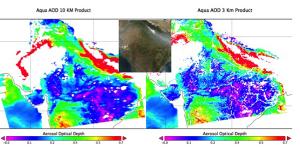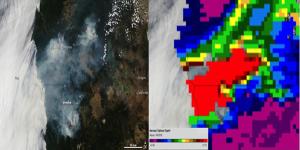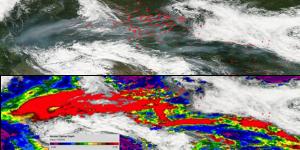Dark Target and the Study of Aerosols
The effect of aerosols is one of the greatest sources of uncertainty in climate modeling. Aerosols vary in time in space and can lead to variations in cloud microphysics, which impact cloud radiative properties and climate. The Dark-Target (DT) aerosol retrieval algorithm is applied to multispectral satellite sensor data, and derives aerosol properties including aerosol optical depth (AOD) over land and ocean, as well as spectral AOD and aerosol size parameters over ocean. Products of the DT retrieval are used to develop global and regional aerosol climatology, to study the interaction of aerosols with clouds, and for air quality assessments and forecasts.
The DT algorithm has been applied to data from the MODIS sensor beginning with the Terra satellite in 1999 and followed by Aqua in 2001. There are actually two separate and distinct “Dark Target” (DT) algorithms. The first one is used for retrieving aerosol information over ocean (dark in visible and longer wavelengths) and the second one over vegetated/dark-soiled land (dark in the visible). The algorithms have been refined and improved continually since the launch of Terra. The updated algorithms are applied to the raw data periodically to produce new data product collections. Currently Terra and Aqua data products are collection 6 (C6).
Although originally developed for use with the MODIS sensors these algorithms can be applied to any sensor that measures reflectance in appropriate wavelength bands covering visible (VIS), near-IR (NIR) and shortwave-IR (SWIR). Currently the DT retrieval algorithm is being ported to additional sensors including VIIRS on SUOMI-NPP, AHI (Himawari) , EPIC (DISCOVR) and the airborne sensor eMAS usually flown on the ER2 and will be applied in the near future to ABI (GOES-R-16).
Before the DT algorithm which was designed for MODIS can be applied to new sensors many factors must be taken into account including:
- Sensor differences such as available wavelengths, width of sensor bands, and sensitivity
- Calibration and characterization differences
- Sampling differences including time of day, orbital coverage, orbital height and measurement geometry
- Pixel selection including cloud and other masking
- Data aggregation and averaging to produce global and/or gridded products
This website is intended to be the primary source of on-line information for the dark-target satellite aerosol retrieval algorithm. Information on the site is intended for both beginners and advanced users. Advanced level users who are already familiar with the algorithm and products should go to the ATBD section for a detailed and mathematical treatment of the algorithm. Newer users should read the algorithm pages to get a detailed overview of how the algorithm works and consult the product pages to understand the content and meaning of the products and where to obtain them. New users are strongly advised to have a complete and thorough understanding of the products and the product quality indicators before making use of them.
Since DT was developed for and has a long history of use with the MODIS sensors the information content on this site refers primarily to the MODIS DT algorithms and products. Specific differences and changes to the algorithm for other sensors are discussed on the platform specific pages.




